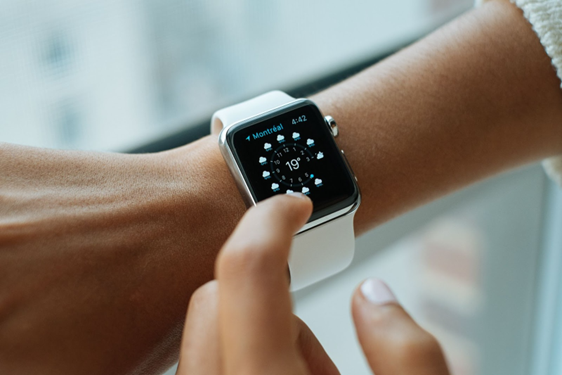
Wearable biosensors are “smart” devices that collect and transmit the wearer’s biometric data through continuous monitoring. This technology, if utilized properly, offers the potential to improve healthcare research by expanding the amount of relevant health data that can be collected and analyzed by researchers and healthcare professionals.
The information monitored includes vital signs, body temperature, heart rate, irregular heart rhythms, ECGs, calories burned, number of steps taken, and much more.
Wearable biosensors use monitoring to transmit biometric human health data by detecting biochemical compounds in bodily fluids such as sweat, tears, and saliva. Biosensors have three parts: bioreactors, transducers, and output systems. These parts collect biometric data for analysis.
Wearable Sensors are available in several forms, including watches, smart clothing, bandaids, blood glucose monitoring patches placed on the chest, and even eye contact lenses. While we have already seen some impressive products come to market, this technology will only improve.
The most mainstream example of a wearable biosensor is the Apple Watch. The internal biosensor wearable technology in the Apple Watch can continuously monitor the wearer’s biometric data in real time through noninvasive monitoring.
By analyzing data on wearable tech, individuals can analyze their heart rate while running. In addition, they can compare their heart rate before running to determine stamina and endurance.
Other people use the technology to reach specific goals, such as tracking the number of steps taken daily. Over the last few years, tracking basic information, like steps, has become increasingly popular, contributing to the increased use of wearable biosensors.

We expect this number to increase as wearable biosensor components become better, cheaper, and more integrated into the legacy healthcare industry. There is still much potential for how this transformative technology will impact healthcare.

Wearable biosensors and smart devices are revolutionary healthcare technologies. Wearable technology has created a medium for collecting increasing amounts of relevant healthcare data and information. This technology makes it possible for individuals to utilize health monitoring to track all of their relevant biometrics and vitals on a 24/7 basis and use this information to understand and monitor human health.
The big takeaway is that wearable biosensors create the ability to collect massive amounts of important personal biometric information for healthcare researchers to analyze and study.
Wearable sensors provide substantial new datasets by enabling a massive expansion of healthcare-related data creation in patient monitoring. The invention and large-scale utilization of these wearable devices could lead us to generate more healthcare discoveries, cure more diseases, and rapidly advance healthcare research.
The burning questions are;
Who owns this valuable data? Where is it stored?
Like all healthcare data, the data generated from wearable devices is stored in siloed databases that cannot connect with external databases. Additionally, the data is not easily accessible.
To maximize the potential healthcare impact of wearable biosensor technology, we need the ability to transmit all collected data to a decentralized database and ledger. In addition, housing all the data (anonymized) on a distributed ledger can solve the “siloed data” problem that currently holds back healthcare research.
The future promises that healthcare will no longer be locked within siloed database environments as it is today. Soon, the data collected from wearable biosensors could be stored on one decentralized blockchain-based computing network. This way, healthcare researchers can deeper analyze the human body and gain access to currently siloed human health information.

The future is bright regarding wearable biosensors, but how does combining wearable sensors and blockchain technology advance healthcare research?
One solution to health monitoring storage is the use of blockchain technology. Blockchain’s core advantages are decentralization, cryptographic security, transparency, and immutability. This technology can transform health data by putting the patient at the center of the healthcare ecosystem. In addition, blockchain technology allows individuals to own their health data and records and earn rewards.
Blockchain technology enables data ownership for the individual, and wearable sensors allow individuals to store and track their biometric data. More people are using smart devices and smartphones to keep track of their health monitoring and data. However, biosensor datasets are stored in siloed environments like hospital data.
Blockchain technology also allows for mass data synthesis and analysis since all data is held on one decentralized ledger and can be analyzed as an entire dataset.

With all the health information generated from the human body and wearable biosensors, the most impactful way to harness this data is to transmit and store it on a global blockchain network that offers security, privacy, individual data ownership, and a connected environment for data synthesis from continuous monitoring devices.
Think about it from the healthcare research perspective. Healthcare research advances by collecting more relevant data points about the human body. The more data points we accumulate, the faster researchers can make discoveries.
We can advance healthcare research by developing technology, such as wearable devices, that allow for the expansion of relevant human health data collection.
The next step for wearable biosensors and health monitoring to maximize impact is to transmit the biometric data collected to a decentralized blockchain network. The result is the creation of a single database for research to be conducted.

What’s really cool about this is that it empowers all people to contribute to advancing healthcare research. Anyone using wearable biosensors for health monitoring can provide real-time health data for researchers. Essential data regarding blood pressure, vital signs, physiological signals, and so much more will be readily accessible to patients and medical personnel. Researchers can then provide more accurate clinical guidance.
You can imagine a future of health monitoring where an individual can utilize wearable devices with continuous monitoring of their blood pressure, heart rate, activity, sleep, and all relevant and valuable biometric data points.
Imagine syncing your wearable biosensor data directly to your doctor to provide them access to stable monitoring performance and a real-time data feed of all the information on your vitals and biometrics. With real-time access to vitals, such as blood pressure and heart rate, your doctor will be immediately aware of any potential issues. With this kind of immediate information, serious complications such as heart attacks will lower mortality rates.
Within their internal software systems, doctors’ offices and hospitals can set up algorithms for future research that analyze all data from their patients’ wearable electronics. The software can create an automatic alert based on specific triggers or conditions within their health data. Therefore, this new technology allows the healthcare industry to offer automated, real-time health monitoring for patients from data they collect daily from wearable devices.
This method leaves nothing to chance. If something changes suddenly with your health, wearable sensors can alert doctors in real-time. Then, you can proactively begin correcting the issue, sometimes before it progresses.
Because of the substantial value of wearable biosensors on many fronts, it’s easy to envision wearable sensors becoming an increasingly integral part of patient care and future research in the medical field. It would not be surprising if hospitals, or even governments, in the future provide a wearable device to people for free or at a meager cost. In addition, data from the human body could be collected from wearable biosensors, creating practical and applicable change across many domains and vantage points of society.

Governments are incentivized to reduce healthcare expenditures; perhaps wearable sensors can minimize disease and general unhealthiness within the country’s population. For instance, universities would love this data for research purposes, and hospitals need it to provide better patient outcomes and make the healthcare experience they offer better and more efficient.
Hopefully, this article has helped illuminate how impactful wearable biosensor technology can become.
For patients, wearable sensors provide an avenue for health monitoring and collecting important data about themselves. It can aid in the early treatment of diseases and quickly resolve personal health issues as they come up in real-time.
From the healthcare research perspective, this technology creates a massive expansion of healthcare datasets. Think about all the valuable new insights about the human body we could glean if everyone wore these devices and synced their health data to the global blockchain!
The magic in healthcare monitoring is collecting and combining many more existing and novel healthcare data points. Wearable biosensor devices could revolutionize healthcare research. This technology can collect this important biometric information in real-time.
